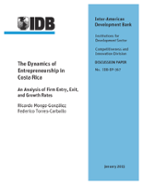The Dynamics of Entrepreneurship in Costa Rica: An Analysis of Firm Entry, Exit, and Growth Rates
Date
Jan 2015
This study explores for the first time the dynamics of entrepreneurship in Costa Rica based on an analysis of firm entry, exit, and growth rates. Using panel data from 2001 to 2012, it explores the extent to which the growth rates of firms are independent of firm size (Gibrat's law), controlling for age and other possible determinants of growth rates. It also analyzes the question of whether Costa Rica is suffering from the missing middle phenomenon. In addition, it explores the questions of which firms are generating more jobs and which companies show high and sustained growth rates (gazelles). The results show an inverse relationship between size and growth rates of firms, even after controlling for age, which does not agree with the predictions of Gibrat's law. In short, it was found that young and small firms are growing faster than older and larger firms in Costa Rica. However, the results also show that large firms are the only ones whose average size increased between 2001 and 2012. It is clear that Costa Rica is not suffering from the missing middle phenomenon, because although there are a very large number of micro and small firms, there is not a bimodal distribution. Indeed, mid-sized firms are missing, but large firms are missing too, and the fraction of firms of a given size is smoothly declining in firm size in all of the years analyzed. On the other hand, a positive and significant relationship between the growth rates of firms and their export experience was found, as well as between the former and firm participation as a local supplier of multinational companies.




